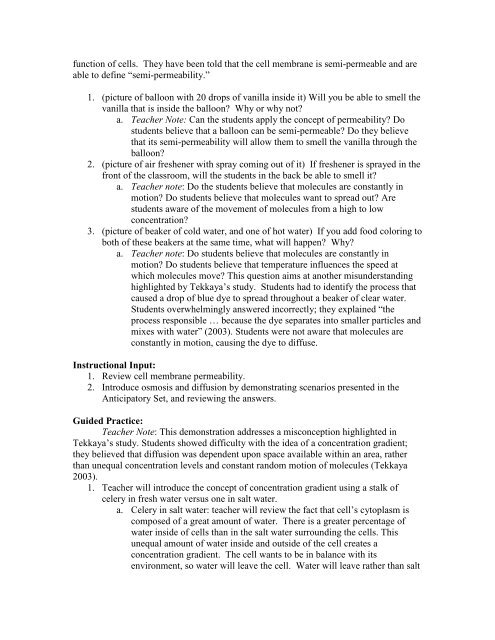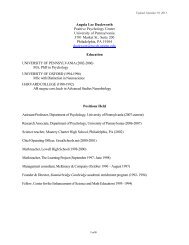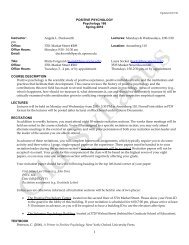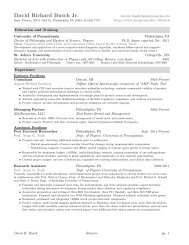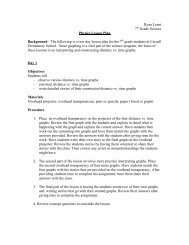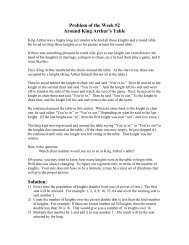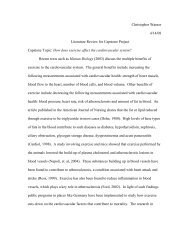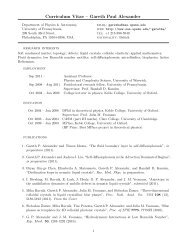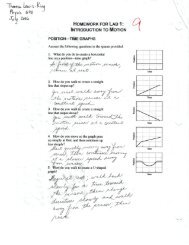Osmosis and Diffusion Audience - School of Arts & Sciences
Osmosis and Diffusion Audience - School of Arts & Sciences
Osmosis and Diffusion Audience - School of Arts & Sciences
Create successful ePaper yourself
Turn your PDF publications into a flip-book with our unique Google optimized e-Paper software.
function <strong>of</strong> cells. They have been told that the cell membrane is semi-permeable <strong>and</strong> are<br />
able to define “semi-permeability.”<br />
1. (picture <strong>of</strong> balloon with 20 drops <strong>of</strong> vanilla inside it) Will you be able to smell the<br />
vanilla that is inside the balloon? Why or why not?<br />
a. Teacher Note: Can the students apply the concept <strong>of</strong> permeability? Do<br />
students believe that a balloon can be semi-permeable? Do they believe<br />
that its semi-permeability will allow them to smell the vanilla through the<br />
balloon?<br />
2. (picture <strong>of</strong> air freshener with spray coming out <strong>of</strong> it) If freshener is sprayed in the<br />
front <strong>of</strong> the classroom, will the students in the back be able to smell it?<br />
a. Teacher note: Do the students believe that molecules are constantly in<br />
motion? Do students believe that molecules want to spread out? Are<br />
students aware <strong>of</strong> the movement <strong>of</strong> molecules from a high to low<br />
concentration?<br />
3. (picture <strong>of</strong> beaker <strong>of</strong> cold water, <strong>and</strong> one <strong>of</strong> hot water) If you add food coloring to<br />
both <strong>of</strong> these beakers at the same time, what will happen? Why?<br />
a. Teacher note: Do students believe that molecules are constantly in<br />
motion? Do students believe that temperature influences the speed at<br />
which molecules move? This question aims at another misunderst<strong>and</strong>ing<br />
highlighted by Tekkaya’s study. Students had to identify the process that<br />
caused a drop <strong>of</strong> blue dye to spread throughout a beaker <strong>of</strong> clear water.<br />
Students overwhelmingly answered incorrectly; they explained “the<br />
process responsible … because the dye separates into smaller particles <strong>and</strong><br />
mixes with water” (2003). Students were not aware that molecules are<br />
constantly in motion, causing the dye to diffuse.<br />
Instructional Input:<br />
1. Review cell membrane permeability.<br />
2. Introduce osmosis <strong>and</strong> diffusion by demonstrating scenarios presented in the<br />
Anticipatory Set, <strong>and</strong> reviewing the answers.<br />
Guided Practice:<br />
Teacher Note: This demonstration addresses a misconception highlighted in<br />
Tekkaya’s study. Students showed difficulty with the idea <strong>of</strong> a concentration gradient;<br />
they believed that diffusion was dependent upon space available within an area, rather<br />
than unequal concentration levels <strong>and</strong> constant r<strong>and</strong>om motion <strong>of</strong> molecules (Tekkaya<br />
2003).<br />
1. Teacher will introduce the concept <strong>of</strong> concentration gradient using a stalk <strong>of</strong><br />
celery in fresh water versus one in salt water.<br />
a. Celery in salt water: teacher will review the fact that cell’s cytoplasm is<br />
composed <strong>of</strong> a great amount <strong>of</strong> water. There is a greater percentage <strong>of</strong><br />
water inside <strong>of</strong> cells than in the salt water surrounding the cells. This<br />
unequal amount <strong>of</strong> water inside <strong>and</strong> outside <strong>of</strong> the cell creates a<br />
concentration gradient. The cell wants to be in balance with its<br />
environment, so water will leave the cell. Water will leave rather than salt


